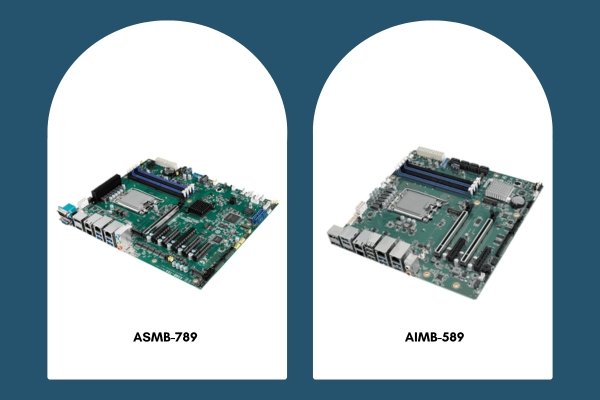When you’re building an AI-driven system or automation solution, choosing the right motherboard isn’t just a technical step it’s the foundation of your entire operation.
With so many industrial-grade options available today, it’s easy to feel overwhelmed. Among the top contenders, two models stand out in the market: Advantech ASMB-789 and Advantech AIMB-589.
Both motherboards serve unique purposes. One is server-grade and ideal for AI and high-performance computing, while the other fits industrial automation setups with budget and space constraints.
In this Blog, we’re breaking down ASMB-789 vs AIMB-589 to help you make an informed decision. Whether you’re integrating machine learning, running automation scripts, or deploying industrial controls, this guide will save you hours of research.
Let’s dive straight in.
Why Choosing the Right Motherboard Matters in AI and Automation
The motherboard connects everything in your system your CPU, memory, GPU, storage, and interfaces. But when you’re dealing with AI inference, industrial automation, or edge computing, regular motherboards don’t always cut it.
Here’s why industrial motherboards like ASMB-789 and AIMB-589 matter:
- AI applications need high-speed data transfer, GPU support, and efficient memory access.
- Automation systems demand long lifecycle support, I/O flexibility, and reliability under continuous load.
- Industrial environments often need extended temperature tolerance, secure boot, and error correction features.
Without the right board, even the most powerful CPU or GPU can’t perform as expected.
A Quick Introduction to ASMB-789 and AIMB-589
Both models are manufactured by Advantech, a known name in industrial computing. But they serve slightly different users.
ASMB-789 Overview
- Designed for high-end AI and server-class applications
- Supports Intel Xeon Scalable processors
- Based on the Intel C621 chipset
- ATX form factor with support for ECC memory
- Up to 384 GB DDR4 RAM
- Ideal for GPU-heavy tasks, machine learning training, and AI inferencing at the edge
AIMB-589 Overview
- Built for industrial automation
- Supports 6th and 7th Gen Intel Core processors (LGA 1151)
- Based on the Intel Q170 chipset
- Micro-ATX form factor
- Up to 64 GB DDR4 RAM
- Perfect for machine vision, PLC control, SCADA, and embedded systems
Both models come with industrial-grade durability, long-term availability, and reliable performance. But the real question is: Which one is right for your use case?
ASMB-789 vs AIMB-589: Detailed Specs Comparison
Let’s look at the two boards side by side.
CPU Compatibility & Chipset
| Feature | ASMB-789 | AIMB-589 |
| Processor Support | Intel Xeon Scalable (LGA 3647) | Intel Core i7/i5/i3 (LGA 1151) |
| Chipset | Intel C621 Server Chipset | Intel Q170 |
| Use Case | Data-heavy AI, Edge Server | Automation, Industrial Control |
The ASMB-789 supports the powerful Xeon family designed for high-performance computing. The AIMB-589, on the other hand, works well with mainstream Intel CPUs, making it more budget-friendly for automation setups.
Memory and Expansion
| Feature | ASMB-789 | AIMB-589 |
| Max RAM | 384 GB DDR4 ECC | 64 GB DDR4 |
| ECC Memory Support | Yes | No |
| RAM Slots | 6 x RDIMM/LRDIMM | 4 x UDIMM |
| PCIe Slots | Multiple x16/x8 (for GPUs, etc.) | x16 + x4 + x1 (limited expansion) |
If your workload involves multiple GPUs, AI model training, or data processing, the ASMB-789’s memory support and PCIe lanes give it a clear edge.
I/O and Connectivity
| Feature | ASMB-789 | AIMB-589 |
| SATA Ports | 10 | 6 |
| USB Ports | USB 3.0, 2.0 (multiple) | USB 3.0, 2.0 |
| LAN | Dual Gigabit Ethernet | Dual Intel LAN |
| RAID Support | Yes | Yes |
| Display Outputs | N/A (Headless) | HDMI, VGA, DVI |
ASMB-789 is headless by design, often used in rack servers or AI clusters. In contrast, AIMB-589 includes video output, making it handy for automation systems with operator interfaces.
Which One Fits Your Use Case?
Let’s make this easier by matching the motherboard to your project type.
Choose ASMB-789 if:
- You’re working on AI inference, training, or image recognition
- You need multi-GPU support or FPGA integration
- Your application runs on server-grade hardware
- You require ECC memory for stability
- You plan to upgrade to future Xeon CPUs
Choose AIMB-589 if:
- You’re building compact industrial control systems
- You don’t need ECC memory or server-level CPU power
- You’re using camera systems, sensors, or HMI displays
- Your budget is limited, and space is a constraint
- Your automation system needs onboard graphics
Real-World Performance Comparison
Let’s see how each motherboard performs in actual industrial scenarios.
ASMB-789 in AI Workloads:
- Capable of handling deep learning frameworks like TensorFlow or PyTorch
- High-speed data throughput and PCIe Gen 3 lanes
- Designed for 24/7 operation with thermal control
- Best used in AI data centers, autonomous systems, or large automation hubs
AIMB-589 in Automation:
- Supports low-power Intel CPUs for efficiency
- Works well with real-time operating systems
- Ideal for PLC programming, SCADA control, or machine vision
- Suitable for use in panel PCs, edge controllers, or industrial IoT
If your work involves AI, real-time object detection, or anything that needs parallel computing, go with ASMB-789. If it’s about cost-effective, space-saving automation, AIMB-589 does the job well.
Future Upgrade Potential
ASMB-789 is designed for scalability. It supports:
- New Xeon CPUs
- More memory via RDIMM slots
- Multiple add-on cards (GPU, RAID, network)
This means your AI system can grow over time.
On the flip side, AIMB-589 is built for fixed-function industrial use. It offers less expansion but stable, long-term support.
So if you’re building a long-life product where updates aren’t needed, AIMB-589 is more practical.
Pricing and Availability
ASMB-789:
- Price is higher due to server-grade components
- Best value for large-scale AI deployments
AIMB-589:
- More affordable
- Great value for industrial projects on a budget
Both boards are available through industrial suppliers, including Global Infotech Solutions, with local support and warranty options.
Final Verdict: Which One Should You Choose?
Still deciding between ASMB-789 vs AIMB-589?
Here’s a simplified view:
Choose ASMB-789 if:
- Your project involves machine learning
- You need a server-class motherboard
- You plan to use multiple GPUs or add-ons
- Stability and memory correction are important
Choose AIMB-589 if:
- Your focus is on compact automation systems
- Budget and size are constraints
- You want a reliable industrial board with display support
- You only need light to moderate processing power
Both boards are excellent but they’re made for different goals.
Frequently Asked Questions
Q1. What is the main difference between ASMB-789 and AIMB-589?
Answer: The ASMB-789 is a server-class motherboard designed for AI and data-heavy applications. AIMB-589 is an industrial Micro-ATX board built for automation, machine control, and display interfaces.
Q2. Is ASMB-789 good for AI workloads?
Answer: Yes. With support for Intel Xeon processors, ECC memory, and multiple PCIe slots, it’s ideal for AI training, inference, and deep learning tasks.
Q3. Can AIMB-589 handle machine vision systems?
Answer: Absolutely. It supports 6th/7th Gen Intel CPUs with onboard graphics, making it suitable for camera-based automation, vision systems, and monitoring stations.
Q4. Which motherboard supports ECC memory?
Answer: ASMB-789 supports ECC (Error-Correcting Code) memory, offering better system stability for mission-critical applications. AIMB-589 does not.
Q5. Which one offers better GPU support?
Answer: ASMB-789 supports multiple PCIe x16 slots and is built for GPU expansion. AIMB-589 has limited PCIe lanes, supporting fewer and smaller add-on cards.
Need Help Choosing the Right Advantech Motherboard?
If you’re still unsure about which board fits your project, our team at Global Infotech Solutions can help you compare, evaluate, and even supply the right motherboard with full integration support.
From AI to automation, we help businesses across industries find hardware that works without overspending or overcomplicating.

